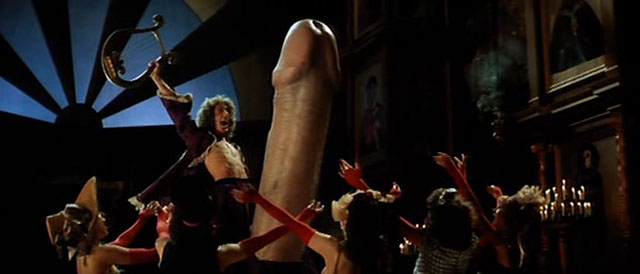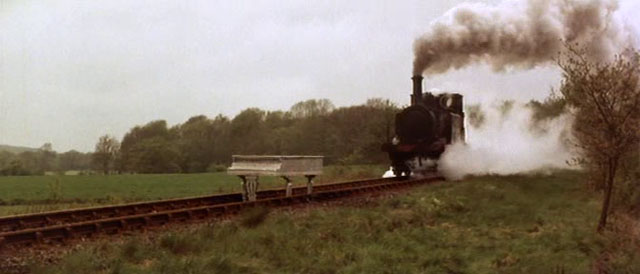Sight & Sound put out their big, big list of the best films ever, and everyone everywhere is talking about Vertigo. I love lists, but am more interested in the individual top tens than the consensus, seeking out the stray title which was ignored by everybody except for one person, who considers it one of the ten best films ever made. So I combed the website – so full of typos, mysteries (Scorsese got 12 picks?) and weird decisions (Manoel de Oliveira, best known for To Each His Own Cinema) – and made myself some must-see lists based on the critics, directors and consensus picks. I’m not making this into a big project-of-the-year and rushing to watch all of these, just making a note to cross ’em off the list if/when I ever get to them.
Unique films from the Directors’ top-ten lists that I haven’t seen:
Aaron Katz
US Go Home (Claire Denis)
Abel Ferrara
Hawks and Sparrows (Pasolini)
Cul-de-Sac (Polanski)
Prison (Bergman)
Agnieszka Holland
Diamonds of the Night (Nemec)
La Reine Margot (Patrice Chereau)
Aki Kaurismaki
Z (Costa-Gavras)
Andrew Kotting
Black Sun (Gary Tarn)
Moon and the Sledgehammer (Philip Trevelyan)
Apichatpong Weerasethakul
La Captive (Akerman)
Rain/Regen (Ivens)
Ben Rivers
Fata Morgana (Herzog)
Perfumed Nightmare (Kidlat Tahimik)
Portrait of Ga (Margaret Tait)
Soft Fiction (Chick Strand)
Weather Diary 3 (Kuchar)
Ben Russell
Christmas on Earth (Barbara Rudin)
Crossroads (Bruce Conner)
Funeral Parade of Roses (Matsumoto)
Heart of Glass (Herzog)
Jaguar (Rouch)
Bong Joon-ho
The Housemaid (Kim Ki-young)
Bruce Robinson
I’m Alright Jack (John Boulting)
Never Give a Sucker an Even Break (Edward Cline)
Charles Burnett
Decision Before Dawn (Anatole Litvak)
Shop on Main Street (Jan Kadar)
Student of Prague (Henrik Galeen)
Tree of Wooden Clogs (Ermano Olmi)
Chris Petit
Eat the Document (Bob Dylan)
The Giant (Michael Klier)
White of the Eye (Donald Cammell)
Corneliu Porumboiu
Faits Divers (Depardon)
Edgar Wright
Dames (Busby Berkeley)
Eugene Green
The Jester (Jose Alvaro Morais)
Fernando Meirelles
Iracerna (Jorge Bodanzky/Orlando Senna)
Fred Kelemen
The Second Circle (Sokurov)
Gaston Kabore
The Thorn Birds (Lee Stanley)
Ugly, Dirty and Bad (Ettore Scola)
Gerardo Naranjo
Possession (Zulawski)
Beware of a Holy Whore (Fassbinder)
Arrebato (Ivan Zulueta)
Gregg Araki
Twin Peaks: Fire Walk With Me (Lynch)
Guy Maddin
Man’s Castle (Borzage)
After Life (Kore-eda)
Gyorgy Palfi
Love (Karoly Makk)
Jiri Menzel
Fireman’s Ball (Forman)
A Dog’s Life (Chaplin)
Joe Swanberg
Dillinger Is Dead (Ferreri)
Two Lovers (Gray)
John Gianvito
The Age of the Earth (Glauber Rocha)
Kuhle Wampe (Brecht/Ottwald)
Reason, Debate and a Tale (Ghatak)
Shiranui Sea (Tsuchimoto Noriaki)
Story of Kindness (Tran Van Thuy)
West Indies (Med Hondo)
Hirokazu Kore-eda
Secret Sunshine (Lee Chang-dong)
Les Blank
Paris at Midnight (E. Mason Hopper)
Lisandro Alonso
Le Havre (Kaurismaki)
Lukas Moodysson
Man on the Roof (Bo Widerberg)
A Swedish Love Story (Roy Andersson)
Mark Romanek
Heaven’s Gate (Cimino)
Michael Glawogger
Vivan las Antipodas! (Kossakovsky)
All My Life (Baillie)
How Yukong Moved the Mountains (Ivens)
Michael Mann
Confessions (Tetsuya)
Miguel Gomes
Francisca (Oliveira)
Mike Hodges
The Prowler (Losey)
Mike Leigh
How a Mosquito Operates (McCay)
The Emigrants (Jan Troell)
Miranda July
Blind (Frederick Wiseman)
Cheese (Mika Rottenberg)
Smooth Talk (Joyce Chopra)
Somewhere in Time (Jeannot Szwarc)
Monte Hellman
Outcast of the Islands (Carol Reed)
Storm Over Asia (Pudovkin)
Olivier Assayas
Ludwig (Visconti)
Van Gogh (Pialat)
Patricio Guzman
Boxing Gym (Wiseman)
Cien Ninos Esperando un Tren (Ignacio Aguero)
Etre et Avoir (Philibert)
Gruningers Fall (Richard Dindo)
Mother Dao (Vincent Monnikendam)
S21: The Khmer Rouge Death Machine (Rithy Panh)
Patrick Keiller
Leaving Jerusalem by Railway (Lumiere)
Peter Davis
Sundays and Cybele (Serge Bourguignon)
Peter Tscherkassky
Adebar (Kubelka)
At Land (Deren)
The Pig (Eustache/Barjol)
Easy Out (Pat O’Neill)
Peter von Bagh
A Man There Was (Sjostrom)
Quentin Tarantino
Pretty Maids All in a Row (Roger Vadim)
Rolling Thunder John Flynn)
Sorcerer (Friedkin)
Raya Martin
Manila by Night (Ishmael Bernal)
Eruption volcanique a la Martinique (Melies)
Robert Gardner
Freeze, Die, Come Alive (Vitali Kanevsky)
My Life as a Dog (Hallstrom)
Rolf de Heer
Fearless (Peter Weir)
The Stud Farm (Andras Kovacs)
Samantha Morton
The Browning Version (Asquith)
Ladybird Ladybird (Loach)
Sean Durkin
Panic in Needle Park (Jerry Schatzberg)
Shinji Aoyama
Hail Mary (Godard)
Killer Elite (Peckinpah)
Sion Sono
Turks Fruit (Verhoeven)
Terence Davies
The Happiest Days of Your Life (Frank Launder)
Victim (Basil Dearden)
Young at Heart (Gordon Douglas)
Terry Jones
I’m No Angel (Wesley Ruggles)
Thom Andersen
God’s Stepchildren (Oscar Micheaux)
Ulrich Kohler
D’est (Akerman)
Ulrich Seidl
My Little Loves (Eustache)
Wanuri Kahiu
Space is the Place (John Coney)
William E Jones
Ten Minutes to Live (Oscar Micheaux)
Unique films from the Critics’ top-ten lists that I haven’t seen:
Craig Keller
23rd Psalm Branch (Brakhage)
Chris Fujiwara
Man’s Favourite Sport? (Hawks)
Amy Taubin
Cosmopolis (Cronenberg)
Ignatiy Vishnevetsky
Red Viburnum (Vasili Shukshin)
Girish Shambu
Dil Se (Mani Ratnam)
Gary Indiana
The Death of Maria Malibran (Schroeter)
Jaime Christley
Ministry of Fear (Lang)
James Naremore
Variety (Bette Gordon)
J Hoberman
The Girl From Chicago (Oscar Micheaux)
Rose Hobart (Joseph Cornell)
Jonathan Romney
Street of Crocodiles (Quay Brothers)
Three Crowns of the Sailor (Ruiz)
Jonathan Rosenbaum
Cuadecuc-Vampir (Portabella)
Kevin Lee
Under the Bridges (Helmut Kautner)
Laura Mulvey
La Signora di Tutti (Max Ophüls)
Mark Cousins
The Insect Woman (Imamura)
Mehrnaz Saeedvafa
The Ladies Man (Jerry Lewis)
Michael Koller
Nostalgia for the Light (Patricio Guzmán)
Mike D’Angelo
Exotica (Egoyan)
Nathan Lee
From the Notebook of (Robert Beavers)
Noel Burch
The Truth About Bebe Donge (Henri Decoin)
Noel Vera
Three Years Without God (Mario O’Hara)
Peter von Bagh
Angèle (Marcel Pagnol)
Quintin
La Libertad (Lisandro Alonso)
Richard Pena
Two Stage Sisters (Xie Jin)
Scott MacDonald
Unsere Afrikareise (Peter Kubelka)
Tag Gallagher
From the Clouds to the Resistance (Straub/Huillet)
Tony Rayns
Scenes from a City Life/Dushi Fengguang (Yuan Muzhi)
Vadim Rizov
The Wedding Suit (Kiarostami)
Eight critics with a bunch of offbeat titles each:
Adrian Martin
Anna (1972, Alberto Grifi/Massimo Sarchielli)
Behindert (1974, Stephen Dwoskin)
By the Bluest of Seas (1935, Boris Barnet/S. Mardanin)
The Departure (1966, Jerzy Skolimowski)
L’Enfant Secret (Philippe Garrel)
Nuit et jour (Chantal Akerman)
Alexander Horwath
I am Twenty (1963, Marlen Khutsiyev)
Line Describing a Cone (1973, Anthony McCall)
My Hand Outstretched to the Winged Distance and Sightless Measure (Robert Beavers)
Reisender Krieger (1981, Christian Schocher)
Schwechater (1958, Peter Kubelka)
Christoph Huber
Arcana (1972, Giulio Questi)
Canyon Passage (Jacques Tourneur)
The Devil Rides Out (Terence Fisher)
The Ducksters (Chuck Jones)
Fiamma che non si spegne (Vittorio Cottafavi)
Ng Long Pat Kua Khuan (Liu Chia-Liang)
On The Silver Globe (1988, Andrzej Zulawski)
The Party (Blake Edwards)
Fred Camper
Egyptian Series (Brakhage)
El Dorado (Hawks)
What Goes Up? (Breer)
Yearning (Naruse)
Gabe Klinger
1126 Dewey Avenue, Apt. 207 (creators unknown)
79 Springtimes (1969, Santiago Ãlvarez)
The Country Doctor (1909, D.W. Griffith)
Wagon Master (John Ford)
Ian Christie
The ‘?’ Motorist (1906, Robert Paul)
A Diary for Timothy (Humphrey Jennings)
Rainbow Dance (Len Lye)
The Sun (Sokurov)
Mark Webber
Eniaios (Gregory J. Markopoulos)
The Hart of London (Jack Chambers)
The Tenant (Polanski)
Work Done (Robert Beavers)
Olaf Möller
Afrique 50 (René Vautier)
Dialogue With a Woman Departed (1980, Leo T. Hurwitz)
The Ditch (Wang Bing)
Introduction to Arnold Schoenberg’s Accompaniment to a Cinematic Scene (1972, Straub/Huillet)
Jom (1981, Ababacar Samb-Makharam)
Outrage (1950, Ida Lupino)
The Year Long Road (1958, Giuseppe De Santis)
Films from the aggregate critics’ top 250 that I haven’t seen, or just haven’t seen lately:
Man with a Movie Camera (Vertov)
Passion of Joan of Arc (Dreyer)
8 1/2 (Fellini)
Late Spring (Ozu)
Au Hasard Balthazar (Bresson)
Mirror (Tarkovsky)
Contempt (Godard)
Andrei Rublev (Tarkovsky)
Shoah (Lanzmann)
Close-Up (Kiarostami)
Gertrud (Dreyer)
The Battle of Algiers (Pontecorvo)
The Mother and the Whore (Eustache)
Wild Strawberries (Bergman)
Night of the Hunter (Laughton)
L’Eclisse (Antonioni)
Beau Travail (Denis)
Fanny and Alexander (Bergman)
Partie de campagne (Renoir)
Aguirre, Wrath of God (Herzog)
The Seventh Seal (Bergman)
Yi Yi (Yang)
Ali: Fear Eats the Soul (Fassbinder)
Imitation of Life (Sirk)
Madame de (Ophuls)
The Conformist (Bertolucci)
The Travelling Players (Angelopoulos)
Two or Three Things I Know About Her (Godard)
Ivan the Terrible (Eisenstein)
Performance (Cammell/Roeg)
The Passenger (Antonioni)
Mouchette (Bresson)
Man Who Shot Liberty Valance (Ford)
Days of Heaven (Malick)
Tropical Malady (Weerasethakul)
L’Argent (Bresson)
Don’t Look Now (Roeg)
The Last Laugh (Murnau)
Memories of Underdevelopment (Alea)
Diary of a Country Priest (Bresson)
Marketa Lazarová (Vlacil)
Solaris (Tarkovsky)
Chimes at Midnight (Welles)
Brief Encounter (Lean)
In a Lonely Place (Ray)
My Neighbour Totoro (Miyazaki)
Only Angels Have Wings (Hawks)
Come And See (Klimov)
Cries and Whispers (Bergman)
Notorious (Hitchcock)
A Trip to the Moon (Melies)
Kind Hearts and Coronets (Hamer)
Grapes of Wrath (Ford)
Paris, Texas (Wenders)
The Music Room (Ray)
A Touch of Zen (King Hu)
Listen to Britain (Jennings)
Day of Wrath (Dreyer)
Thin Red Line (Malick)
The Conversation (Coppola)
Red Desert (Antonioni)
Kings of the Road (Wenders)
Berlin Alexanderplatz (Fassbinder)
Daisies (Chytilova)
West of the Tracks (Bing)
The Big Sleep (Hawks)
Wanda (Loden)
The Devil Probably (Bresson)
Floating Clouds (Naruse)
Two-Lane Blacktop (Hellman)
The Thin Blue Line (Morris)
The World of Apu (Ray)
The Testament of Dr Mabuse (Lang)
Kes (Loach)
Three Colours: Red (Kieslowski)
Attn: BFI, Critics, etc – this is a personal checklist made from severely abridged selections from the Sight & Sound lists, but if I’ve reposted too much of your content, give a yell and I’ll take this post offline.




























